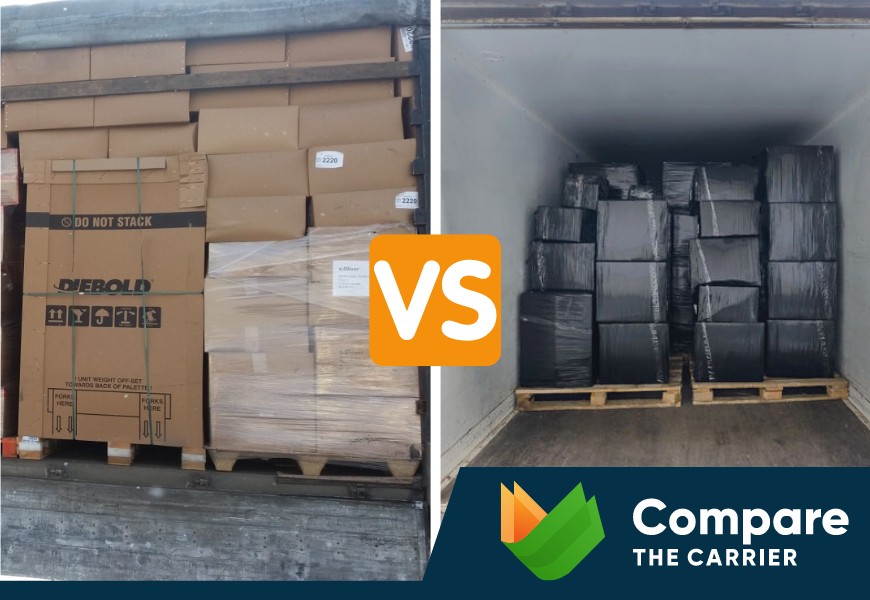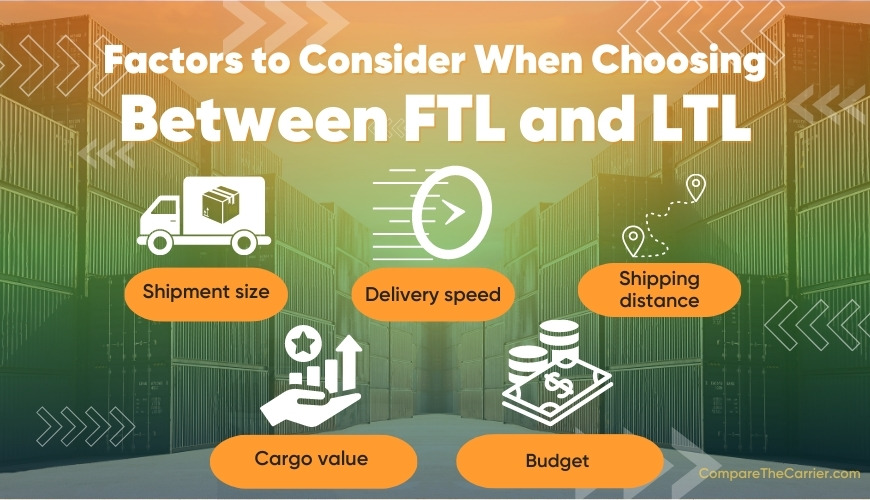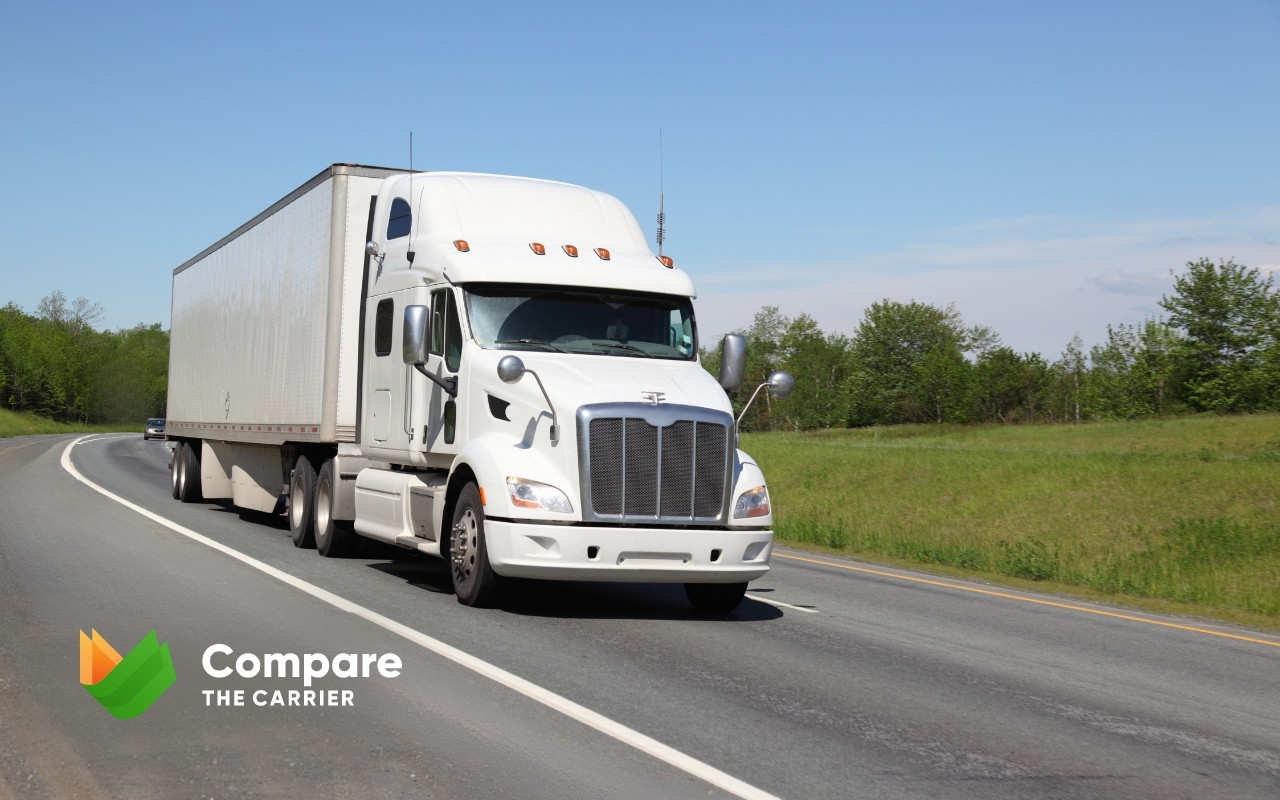Freight shipping is pretty much the heartbeat of America’s commerce, moving a whopping 51.5 million tons of freight every day. Whether you’re a business big shot transporting pallets across states or just an Average Joe moving your life’s belongings to a new city, picking the right shipping choice can seem like rocket science. But don’t sweat it, we’re here to walk you through the ins and outs, and the difference between FTL and LTL freight shipping. We’ll dive into the cost factors, time efficiency, and even guide you in picking the option that fits your needs like a glove.
Understanding FTL and LTL Freight Shipping:
What They Don’t Tell You

Picture this – you’re at a fork in the road. One path leads to Full Truckload (FTL) shipping and the other to Less Than Truckload (LTL) shipping. Which route should you take? Well, that depends on the size of your shipment.
FTL is the muscle car of freight shipping. It’s where your cargo struts its stuff, taking up the entire truck. This route is the kingpin when you’ve got a substantial amount of goods to ship. Think of an FTL truck as your personal cargo jet – it carries only your goods, heading straight from point A to point B. It’s all about getting big, heavy loads to their destination, quickly and directly.
LTL, on the other hand, is like carpooling for your cargo. If your shipment isn’t quite big enough to fill a whole truck, it’ll hitch a ride with other smaller shipments. The truck, in this case, is like a school bus making several stops, picking up and dropping off goods along the way. This means your goods might take a little detour before reaching their final destination, but hey, they’re in good company!
In the heavyweight category, we usually see FTL shipments – they’re larger and pack more volume. LTL shipments, on the other hand, are the welterweights of freight – smaller and easier to manage. When time’s ticking, FTL shipping generally finishes first, taking a direct route from pickup to delivery. LTL shipping, though, might take a tad longer since it makes pit stops to pick up and drop off other shipments.
If you’ve got a precious cargo that requires white-glove handling, FTL is usually your safest bet. It offers higher security and minimal handling since it’s a one-way ticket from your pickup point to your delivery point. But, if your shipment is smaller and flexible with time, then LTL can be a more cost-efficient option.
So, to navigate the freight shipping landscape, you gotta understand the basic differences between FTL and LTL. That way, you can select the option that best aligns with your shipping needs. Remember, it’s not just about moving goods; it’s about choosing the best route for your cargo’s journey.
Cost Implications: The Hidden Truth About FTL and LTL Costs

Let’s cut to the chase: freight shipping isn’t free. The cost of moving your goods from point A to point B is a major factor when deciding between FTL and LTL shipping. So, what’s the financial lowdown on these two options?
If your shipment fills up a truck, you’re looking at FTL shipping. But here’s the deal – while it’s faster and more direct, it also carries a heftier price tag. You see, when you book an FTL shipment, you’re renting out the whole truck – it’s like hiring a limo for a solo ride. The cost isn’t split with anyone else, which means your wallet carries the entire load. Additionally, FTL shipments have a higher minimum charge, which can feel like a financial punch in the gut if your load is on the smaller side.
Now, let’s swing over to LTL. If your shipment is lighter and less voluminous, choosing LTL can save you some cash. With LTL, your shipment shares the ride with others, and so does the cost. It’s like carpooling – you and a few others split the cost of the ride. You’re only paying for the weight and volume of your shipment, not the entire truck.
And, don’t forget about the fuel! Fuel surcharges are another player in the cost game. With FTL, these charges can be higher due to the bigger, heavier loads. LTL, on the other hand, tends to have lower fuel surcharges since the cost of fuel is shared among all the shipments in the truck.
When it boils down to it, your final shipping cost will depend on several factors, including the size of your shipment, the distance it needs to travel, and how fast you need it delivered. So, whether you’re leaning towards FTL or LTL, it’s crucial to crunch these numbers and understand the cost implications. That way, you can choose the option that gives you the most bang for your buck. Remember, smart shipping decisions are all about maximizing value while minimizing cost.
Time Efficiency: FTL vs LTL – A Race Against the Clock

Okay, let’s talk about time. When it comes to getting your shipment from A to B, is FTL the speedy race car or is it the tortoise to LTL’s hare?
If you’ve got your money on FTL to be first across the finish line, you’ve hit the jackpot. FTL shipping typically takes the gold medal for speed. Think of it like a non-stop flight – your shipment goes directly from pickup to delivery, without any layovers. There’s no time wasted making multiple stops or transfers, which keeps your shipment moving and gets it to its destination faster.
LTL shipping, on the other hand, is more like a road trip with pit stops. Your shipment shares the ride with others, meaning it might stop to pick up more passengers or drop some off along the way. This pit stop process, called consolidation and deconsolidation, can make the journey a bit longer. But don’t dismiss LTL just yet – its strength lies in its flexibility. It’s the king of multitasking, juggling multiple pickups and deliveries along its route.
However, just like any race, the outcome can change based on the track. For long-haul shipments, FTL typically takes the trophy, thanks to its direct route. But if we’re talking shorter distances or regional shipments, LTL might pull ahead with its ability to efficiently handle multiple smaller deliveries.
Like any good race strategy, choosing between FTL and LTL isn’t just about speed. It’s about understanding your shipping needs – the size of your shipment, the distance it’s traveling, and your delivery deadlines. By considering these factors, you can choose the freight shipping option that gets your shipment to the finish line on time, and keeps your wallet happy, too.
Choosing the Right Option: The Difference Between FTL and LTL – The Ultimate Dilemma
Now that we’ve unpacked the ins and outs of FTL and LTL shipping, it’s time to play matchmaker and find the perfect fit for your freight shipping needs. Choosing between FTL and LTL is like dating – you have to know what you’re looking for and what your deal-breakers are. Let’s break down the main factors to consider:

Choosing between FTL and LTL is all about knowing your needs and understanding what each option brings to the table. And remember, no matter which option you go with, you want to ensure you’re working with a reliable and trustworthy carrier – after all, your shipment deserves the best!
Choosing between FTL and LTL freight shipping doesn’t have to feel like navigating through a labyrinth. It’s about understanding the basic differences, and then considering your shipment size, distance, speed, and budget to find your perfect match. FTL is your go-to for larger shipments that need quick, direct transport, while LTL shines for smaller, less urgent loads. Both have their strengths, and the right choice depends on your unique needs.
But no matter which route you choose, remember that who you partner with matters. At Compare The Carrier, we’re committed to offering you licensed, professional carriers that deliver not only your shipment, but also peace of mind. As a reliable guiding hand in your freight shipping journey, we’re here to help you make the best decision – saving you time, money, and unwanted stress.
So, when it comes to shipping your precious cargo, you know you can count on us to get it there safely, cost-effectively, and on time.
With Compare The Carrier, you’ve got this freight shipping thing in the bag!
FAQ
Can I switch between FTL and LTL shipping for different shipments?
Absolutely. Your shipping needs might vary depending on the size of your shipment, the distance, and how quickly it needs to arrive. You can choose the most appropriate option for each individual shipment.
Are there other types of freight shipping options aside from FTL and LTL?
Yes, other options include parcel carriers for small packages and intermodal freight for long-distance, large-scale shipments. The right option depends on your specific shipping needs.
How can I calculate the cost of my LTL shipment?
The cost of an LTL shipment typically depends on factors such as weight, dimensions, distance, freight class (determined by the NMFTA), and additional services like liftgate delivery or residential pickup/delivery.
How secure is LTL shipping?
While LTL shipments are generally safe, they do entail more handling as they’re loaded and unloaded at multiple terminals. This increases the risk of damage or loss compared to FTL shipping, which offers more direct routes.
What’s the maximum weight I can ship with LTL?
LTL shipments typically range from 150 pounds to around 15,000 pounds. Anything larger might require a partial or full truckload service.
Do I need to insure my shipment?
It’s a good idea to consider insurance for your shipment, especially for high-value goods. While carriers do provide a level of liability coverage, it might not cover the full value of your goods.







